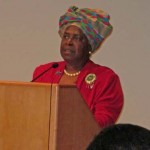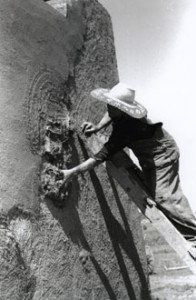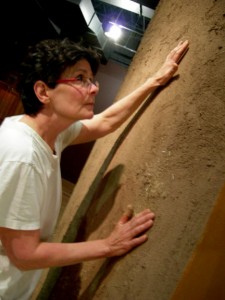 The new exhibition on the museum’s second floor, New Mexico’s African American Legacy: Visible, Vital, Valuable, has been drawing visitors keen to learn more about how Black families planted their roots in Las Cruces and Albuquerque. At the exhibition’s opening last month, we were particularly honored by Dr. Doris A. Fields, who wrote a poem specifically for the exhibition’s stay at the New Mexico History Museum, through Oct. 9.
The new exhibition on the museum’s second floor, New Mexico’s African American Legacy: Visible, Vital, Valuable, has been drawing visitors keen to learn more about how Black families planted their roots in Las Cruces and Albuquerque. At the exhibition’s opening last month, we were particularly honored by Dr. Doris A. Fields, who wrote a poem specifically for the exhibition’s stay at the New Mexico History Museum, through Oct. 9.
She graciously agreed to allow us to reprint it (below) that we might share it with an even larger audience. (Personally, my heart felt an extra thump when she read the line, “Selling goods/not being goods sold.”)
Doris is a performance artist and poet whose work has appeared in publications like the most recent issue of Malpais Review. She holds a doctorate in International Communication Competence, is an activist and scholar of health care, and teaches a variety of courses at the University of New Mexico, including “Health Issues in Death and Dying” and “Stress Management.” She has conducted workshops for Black women, gifted students and women across cultural differences.
On top of all that, she’s simply one of the warmest people you’ll ever be lucky enough to meet. Her poem has now entered the archives of the Fray Angelico Chavez History Library, and we hope you’ll enjoy it here, as well.
Movers and Journeys in Freedom
Sacred -ness
Of footprints
Impressions in dust
Rising like phoenix powder
Free to drift to roam
Settle where Ever
It pleases
That is the implication of freedom
Visible:
Seen
I see you do you see
You see me
Peer through eyes
Of dead soldiers
Heads of wool
Come alive
Dressed in foreign fare
Traditional skins
Left on mother continent’s shores
Left behind
Iridescence you see
Threads a cultural quilt into being
Being as how
The vital organs of existence
Shed
A shelter of light -ness
Vital:
Critical for survival freedom
Build churches towns
Blackdom
Vado
Links to Eatonville
Miners mine coal gold
Silver turquoise
Defying stereotype
Lawyers archeologists pastors
Soldiers salesmen cowboys
In saddle
Ride the range
Imagine
African silhouette in one
Brilliant orange
Horizon
Valuable:
Markets cannot dictate
What determination mitigates
Retailers wholesalers
Selling goods not being goods sold
Unquenchable thirst for knowledge
Drinking freedom like moonshine on a Saturday night
Soak up dried desert bones
Swallow life whole
Breathe in
Life
To break chains
Explore depths of death-defying souls
Turn earth water seed
Into apples pears peas
Quench thirst for freedom
Resolve that skills count
More than color
Ingenious to wash alkali from soil
Enrich dirt with brown sweat
Talk of promise
Teach the soil its own potential
Black soil black dirt
Fertile as Africa herself
Cooks porters rail workers
Link with Chinese to join
West with East South to North
Find faith in one another
Hearers of G-d
Finding G-d inside
Outside the limiting expectation
Visible Vital Valuable
These are the sounds of freedom
Doris Fields
05/14/ 2011
Mei




